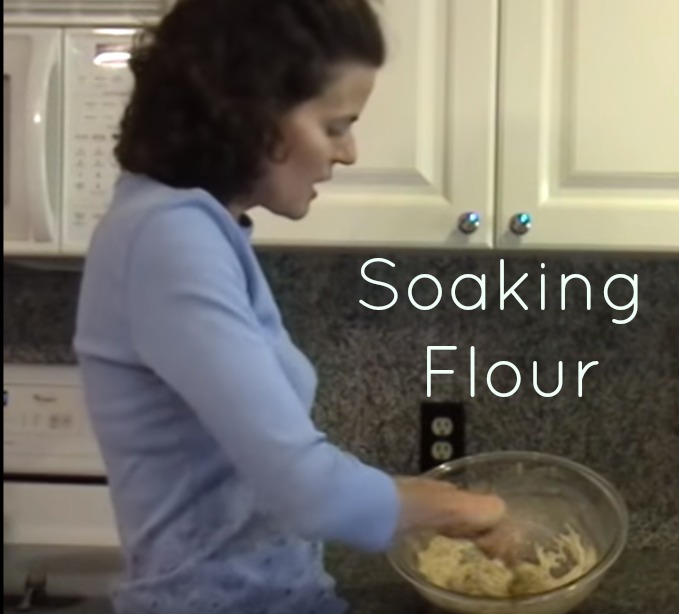Table of Contents[Hide][Show]
Soaking flour for maximum digestibility is one of the three traditional methods of grain preparation for healthy, nutritious bread as practiced by Ancestral cultures.
One of the most important baking techniques to learn when implementing a traditional diet is soaked flour. This ancestral method of grain preparation enhances digestibility and improves the metabolism of nutrients.
This technique also reduces anti-nutrients such as phytic acid in the grain flour. These substances block mineral absorption and can aggravate inflammation of the intestinal tract. Gluten-free grains also contain these anti-nutrients.
Other methods for reducing anti-nutrients in grains and improving metabolism include sour leavening (sourdough) and sprouting.
How to Soak Flour
Soaking flour is simple. Simply mix grain flour with yogurt, kefir, or clabbered milk, cover with a dishtowel, and let sit on the counter overnight. Freshly ground flour produces the best results. After the allotted soaking time, blend in the remaining ingredients and bake or cook as usual.
Non-grain based flours such as cassava and coconut flour do not need soaking. Others such as almond flour and chickpea flour are best soaked before grinding rather than after.
Dairy-Free
For those with milk allergies, substitute 1 cup of filtered water per cup of flour plus 2 TBL of lemon juice or apple cider vinegar and soak as usual for at least 8 hours or overnight.
For those with more extreme wheat sensitivities, the soaking time can be increased up to 24 hours to further breakdown gluten and other anti-nutrients.
Soaking any longer than 24 hours risks the development of mold.
Soaking Flour Technique Applies to All Grains
The principle of soaking can be applied to whole grains as well, such as your morning oatmeal. It was common to soak oats overnight before cooking back before WWII. This step was apparently even suggested on the Quaker oatmeal box!
It seems with the modern preference for speed in food preparation, this essential step has been lost. Hardly anyone under the age of 80 even remembers it anymore.
Try soaking your oatmeal the night before and see how much more filling it is after you cook and eat it the next morning.
Instead of being hungry again at 10 am, you will likely be full right through until lunch! To soak oatmeal, use 1 cup of warm filtered water per cup of oats plus 2 TBL whey, yogurt, kefir, or buttermilk. Stir together in the pot you will cook them in, cover with the lid, and leave overnight.
Cook, as usual, the next morning.
Bread Recipes Using Soaked Flour
Try this soaked bread recipe with your soaked flour. You can also try making a soaked loaf in a bread machine.
The video in the recipe tutorial below demonstrates visually the simple process of soaking flour. Try it with your next flour-based recipe!

How to Soak Flour
How to soak flour of all kinds before making the batter to improve digestibility and nutritional benefits of bread and other baked goods.
Ingredients
- 2 cups flour preferably freshly ground and organic
- 2 cups whole milk yogurt
Instructions
-
Mix flour and yogurt in a large bowl.
-
Cover with a clean dishcloth and secure with a large rubber band.
-
Leave on the counter overnight or for 8 hours.
-
Uncover, mix in remaining ingredients for whatever recipe you wish to make and bake as usual.
Recipe Video
Recipe Notes
Clabbered milk or plain kefir may be substituted for yogurt.
If there is a dairy allergy, 2 cups of water plus 2 Tbl lemon juice may be substituted. This reduces the calories to 910 for one batch.








I would also love to have the recipe for making pancakes! Thank You!
HI Sarah,
Have you seen new information about not soaking rains with dairy?
Just wondering your thoughts
Thank you for this wonderful video! My mom made sour milk every time we brought home too much milk from our uncle’s cows. It tasted really good (we ate it with a spoon) and I now make sour milk when I have milk left over from my yoghurt making. We drink whatever liquid doesn’t ‘solidify’ during the sour milk making ‘process’.
After I make butter the buttermilk doesn’t seem to last long. Can I use soured buttermilk to soak the wheat for pancakes?
Hi Sarah,
I have been enjoying your videos and blogs. I am thankful for your wealth of information. I saw your soaking flour video, but I can’t find the rest of the recipe for the pancakes. Could you send it to me or tell me where it is?
Thanks! Luisa
Thanks so much! I’m working with a delicate Gluten-Free Low-Carb Bake Mix, so this will be an interesting experiment.
Quick question: With that much liquid – 1 cup liquid per 1 cup flour for soaking, surely that will make a difference to the recipe and how much liquid is required after that. Say, the recipe required only 1 cup of liquid/wet ingredients – does it still require exactly the same amount? It almost defies my understanding to say, yes, as the flour mixture will be quite wet and would have absorbed a cup of liquid already. I’m confused. Thanks for any enlightenment you can give me. I will be posting on this subject soon and would like to give the right information. I will link to you in my post. Thanks again.
Hi Jennifer, after the soaking is complete, if you have any residual liquid you can pour it off and then add the remaining ingredients. Sometimes I have residual liquid and sometimes I don’t. It is the inherent unpredictability of cooking from scratch I suppose! I have never reduced any liquids in the main recipe to compensate for the soaking liquid and everything always seems to turn out fine! 🙂
Thanks for the video! It answered most of my soaking questions. One more though – we are going camping next week and we typically eat pancakes at least one morning. In an effort to reduce my “to do” list while we’re camping I like to prepare things ahead of time. Can soaked grain be stored for any length of time (in the refrigerator or cooler in this case) ?
blessings!
Hi Danielle, yes you can store soaked grain for a day or two in a tightly sealed container that is kept cold.
Hi Lauren, yes buckwheat would need to be soaked as well. It is best to buy regular rolled oats and not quick oats. Quick oats need to also be soaked though. Glad you are enjoying the blog! Good luck with the kefir soda!
Hi Sarah,
I am just a little confused on how to use the soaked flour/oats. When preparing the final product (oatmeal, pancakes, etc.) do add the regular amount of water/milk that the recipe calls for? Also, for the flour you grind, how long would you think it keeps in the freezer? I would like to start doing this, but I don’t use a whole lot of flour, and I want to make sure it wouldn’t go bad.
Thanks!!
-Lauren
Hi Lauren, the flour freezes beautifully for several months. I’ve never had it get freezer burn or be not good before I’ve used it all up. Yes, add the regular amount of milk/water that the recipe calls for once you’ve soaked the flour.
One more question!! Well, two, haha. First, do you recommend soaking buckwheat before using? I know it’s not a “grain” but because it’s so gain-like I didn’t know if that was a good idea. Also, for oatmeal in the morning, I usually use McCann’s Quick and Easy Oats (the ones that take 5 minutes). Should I be soaking these as well? I just wasn’t sure since they’re instant-ish.
Thanks so much!
P.S. I am LOVING your site.. Just got kefir grains, and getting ready to make my first batch of soda tonight 😀 sooo excited!